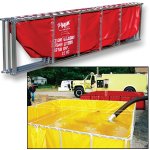atgreene
Platinum Member
- Joined
- Aug 10, 2007
- Messages
- 855
- Location
- Sebago, Maine
- Tractor
- 2005 TB135 Excavator with Thumb, Quick Attach System, Ripper tooth, 3' Hydrauic Tilt Clean-up Bucket, Skeleton Bucket, 1986 Kubota 4150 with Loader and Quick Attach with Woods Forks, JD B, 1963 IH 504
Wow, great thread.
As a fire fighter out East I seldom get to see the size fire you folks have to deal with.
A couple thoughts:
Pumps, go for pressure over volume when dealing with nozzles and sprinklers. You need reach and enough pressure to create a stream tight enough and hard enough to reach what you need to. A volume pump at 15 psi may not even be enough to take the kinks out of the hose.
O2 tank, better off getting a SCUBA tank with compressed air or use a compressor tank. Pure O2 under a cloth tarp would cause one heck of a fire when ignited. Be very careful.
Tanks, would a fold-a-tank work for what you need? Fill it during fire season or when needed? Cheap, lightweight and can be used by the FD easily. Portable Collapsible Fol-Da-Tank | Water Supplies | Dump Tanks |
Sprinklers are great, but they may cause the barricade or foam to be washed off. You may want to go with one or the other.
Hose fittings. Unless there is something different from here, FD's and Forest service usually use Iron pipe for forestry (1-1/2") and National standard for larger hose. Iron pipe is a much finer thread than National, I'd suggest checking with them and make all yours the same as theirs.
Good luck!
As a fire fighter out East I seldom get to see the size fire you folks have to deal with.
A couple thoughts:
Pumps, go for pressure over volume when dealing with nozzles and sprinklers. You need reach and enough pressure to create a stream tight enough and hard enough to reach what you need to. A volume pump at 15 psi may not even be enough to take the kinks out of the hose.
O2 tank, better off getting a SCUBA tank with compressed air or use a compressor tank. Pure O2 under a cloth tarp would cause one heck of a fire when ignited. Be very careful.
Tanks, would a fold-a-tank work for what you need? Fill it during fire season or when needed? Cheap, lightweight and can be used by the FD easily. Portable Collapsible Fol-Da-Tank | Water Supplies | Dump Tanks |
Sprinklers are great, but they may cause the barricade or foam to be washed off. You may want to go with one or the other.
Hose fittings. Unless there is something different from here, FD's and Forest service usually use Iron pipe for forestry (1-1/2") and National standard for larger hose. Iron pipe is a much finer thread than National, I'd suggest checking with them and make all yours the same as theirs.
Good luck!

